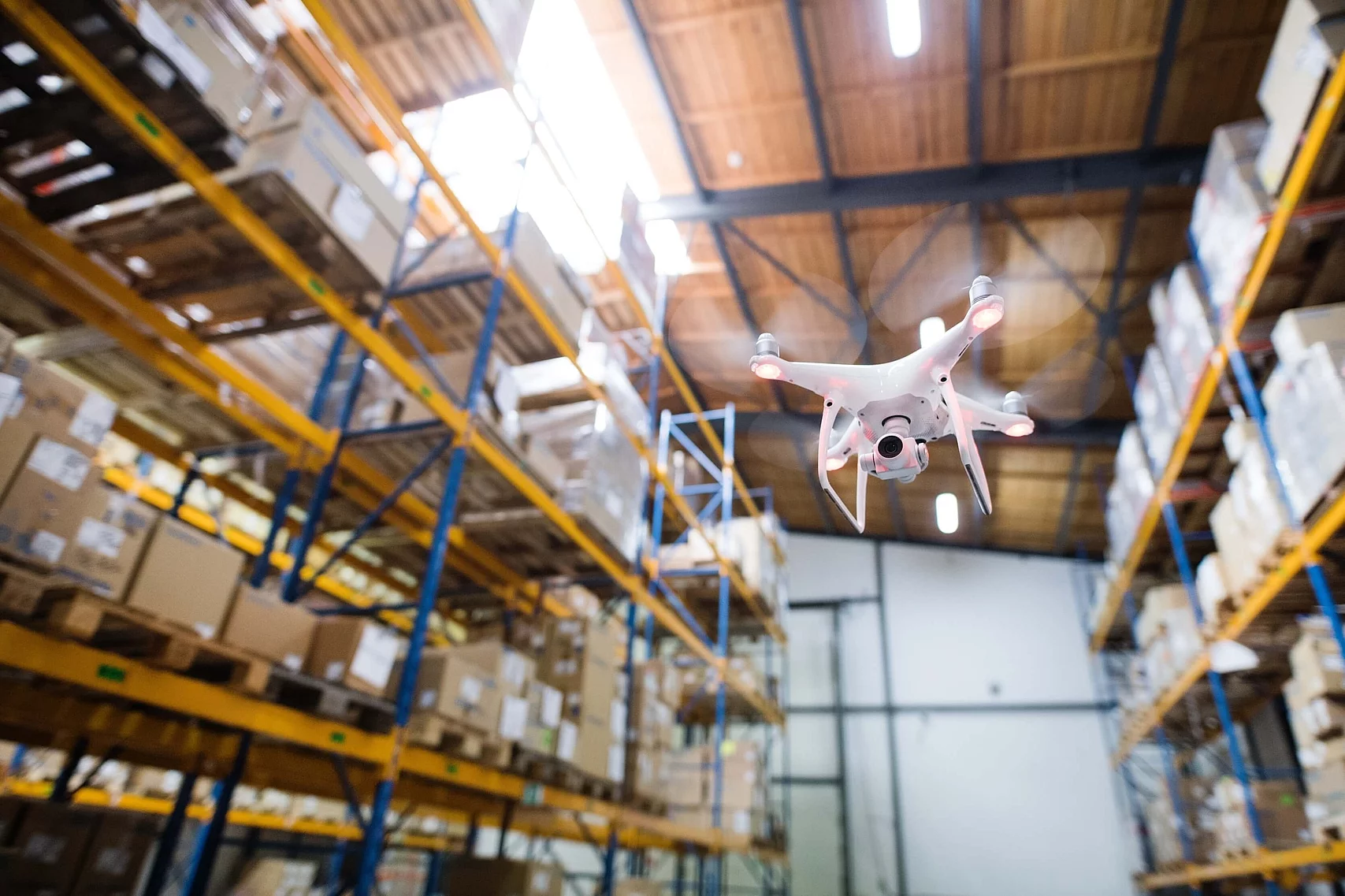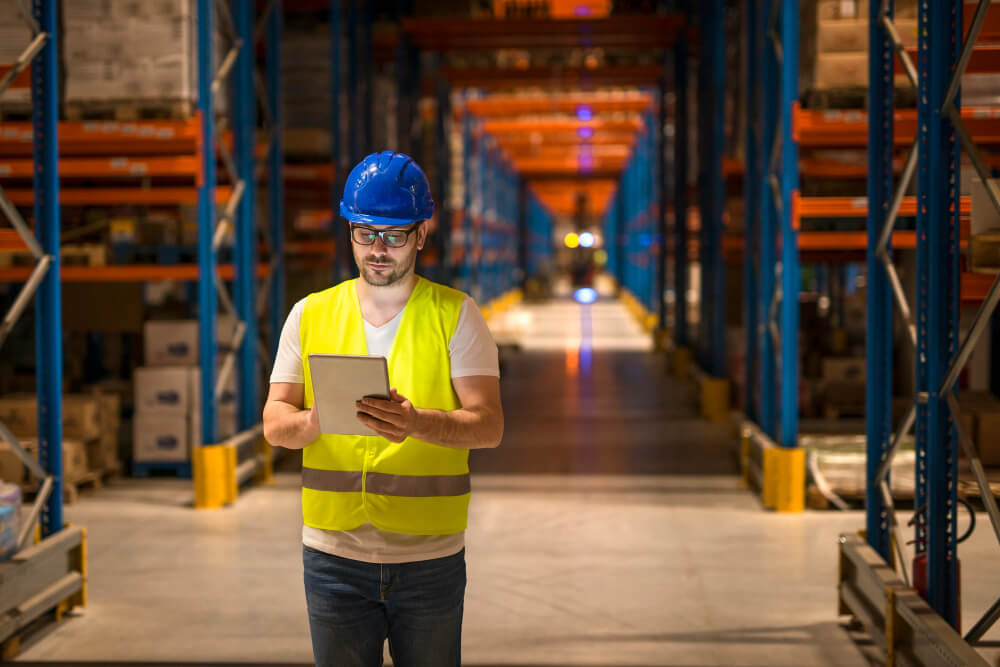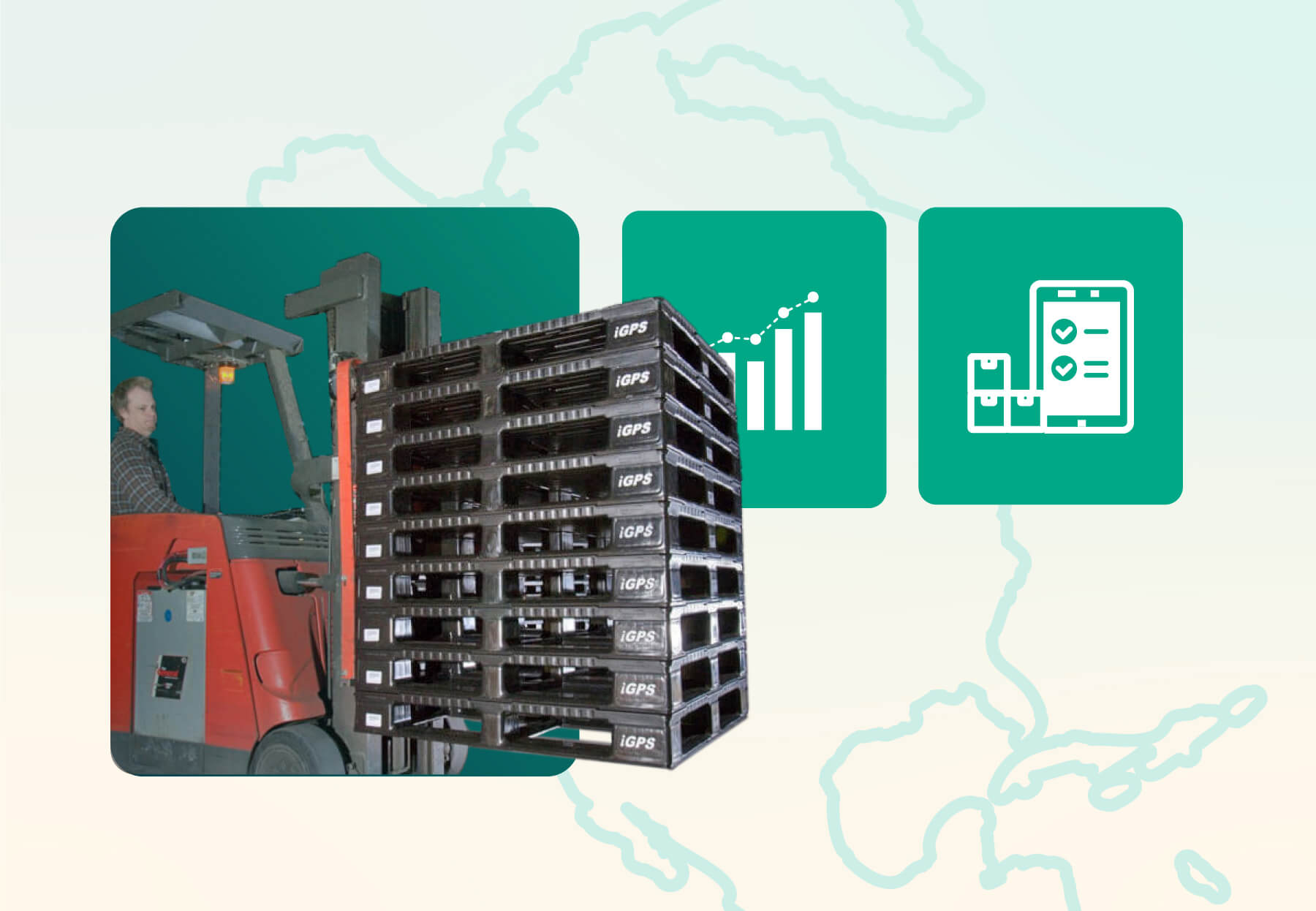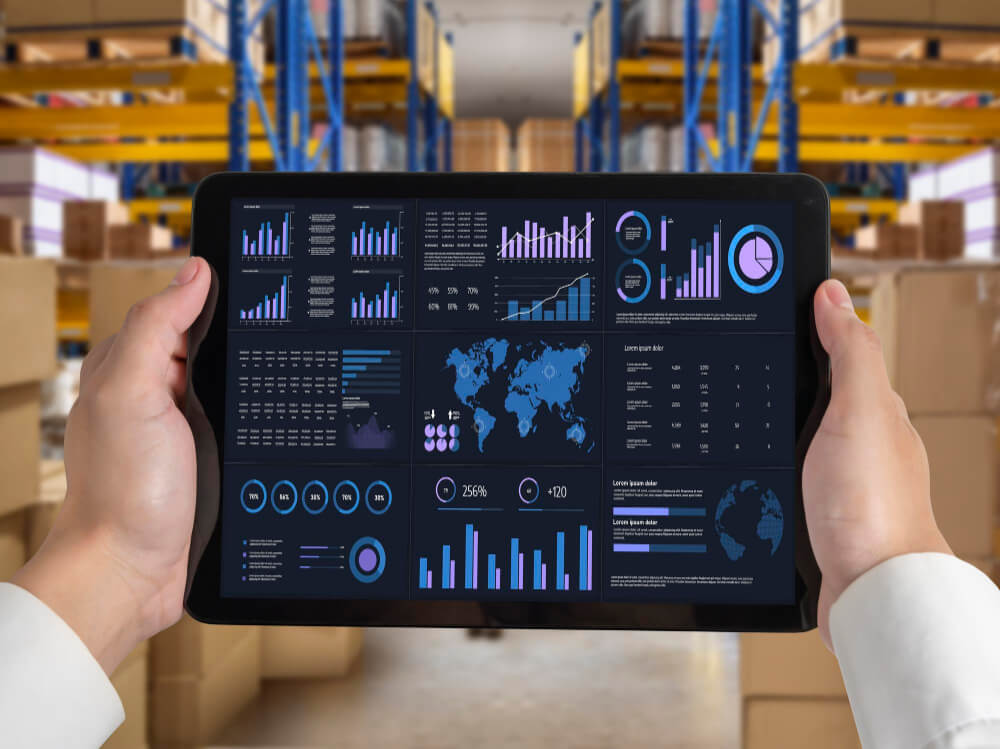Key Takeaways
- Autonomous or semi-autonomous flying devices, called Warehouse drones, are designed to streamline tasks like inventory scanning, shelf inspections, and compliance checks.
- To operate safely in complex indoor environments, they use advanced technologies such as LiDAR, RFID/barcode scanners, and SLAM navigation.
- A few key benefits include reduced labor costs, faster inventory counts, improved safety, and real-time data sharing.
- Large corporations like Walmart, IKEA, and Geodis are already using warehouse drones to boost operational accuracy and efficiency.
- Integration with existing systems, high upfront costs, and the need for employee training and safety considerations are a few challenges that warehouse drones present, despite the benefits.
- AI-driven analytics, swarm coordination, and deeper integration with smart logistics systems are where the future of warehouse drones is headed!
What are Warehouse Drones?
Designed specifically to support operations in warehouses, fulfillment centers, and distribution hubs, warehouse drones are unmanned aerial vehicles (UAVs). These flying machines are autonomous or semi-autonomous, and equipped with cameras, sensors, and software that allow them to perform tasks such as inventory scanning, cycle counting, barcode reading, and even shelf inspections.
Traditional drones, often used in outdoor settings, are different from warehouse drones as warehouse drones can operate safely and accurately indoors in environments filled with tall racks, narrow aisles, and human workers. Built to integrate seamlessly with warehouse management systems (WMS), robotics platforms, and data analytics tools, they can fly in GPS-denied spaces easily.
Types of Warehouse Drones and Their Technologies
Each designed with specialized functions in mind, there are several types of drones utilized in warehouse environments. Some are built for scanning inventory, while others focus on material movement or environmental monitoring.
Common types include:
- Inventory Scanning Drones: Equipped with high-resolution cameras and barcode/RFID scanners to conduct real-time inventory audits.
- Surveillance Drones: These drones can monitor unauthorized access or hazardous conditions and are used primarily for security and safety checks,
- Delivery or Transport Drones: Some warehouses experiment with drones capable of lifting and transporting small packages between zones, although this is less common in indoor spaces.
Key enabling technologies:
- LiDAR and Vision Navigation: For spatial awareness and obstacle detection.
- SLAM (Simultaneous Localization and Mapping): Helps drones map and navigate their environment in real time.
- RFID/Barcode Scanners: Integrated to transmit and capture item-specific data.
- Autonomous Flight Software: Enables pre-programmed route mapping, data synchronization with WMS platforms, and obstacle avoidance.
Benefits of Using Warehouse Drones
In areas where manual labor is costly, time-consuming, or error-prone, implementing drones in warehouse operations offers several compelling benefits.
Major advantages include:
- Faster Inventory Audits: Drones can scan shelves much quicker than humans, reducing full cycle counts from full weeks to hours.
- Labor Savings: Tasks that once required several employees and different equipment (like scissor lifts) can now be done by a single drone with minimal to no supervision.
- Improved Safety: Drones reduce the chance of worker injury by taking over high-risk tasks such as checking inventory on tall racks.
- Real-Time Data Access: Supporting better decision-making and reducing out-of-stock or overstock scenarios, drones can transmit data instantly to warehouse systems.
- Operational Efficiency: Without halting operations, drones enable more frequent cycle counting, leading to cleaner and more accurate inventory records.
Examples of Use Cases
To solve logistical challenges across industries, warehouse drones are being deployed in a variety of ways. Most common applications include:
- Automated Cycle Counting: To verify stock levels with high accuracy, drones fly from aisle to aisle, scanning barcodes and RFID tags.
- Lost Item Location: Drones can quickly identify misplaced items using visual markers or tag scans, instead of workers manually searching through rows.
- Compliance Checks: Drones help confirm that products are stored properly and in the right conditions, in highly regulated industries like pharmaceuticals.
- Warehouse Mapping: Drones provide 3D maps for layout optimization for newly set-up warehouses or renovations.
- Safety Inspections: To ensure facility compliance and employee safety, drones inspect lighting, HVAC systems, and fire exits in hard-to-reach areas.
Examples of Companies Using Warehouse Drones
Several forward-thinking companies and logistics providers are already integrating drone technology into their warehouse operations.
- IKEA: To boost nighttime productivity, drone technology firms scan inventory outside of operational hours.
- Geodis: Cutting inventory check times by over 90%, Geodis implemented drone-based stock tracking systems in their European warehouses.
- Amazon: Amazon has also explored indoor drone technologies in its robotics-focused fulfillment centers, although it is more famous for outdoor delivery drones.
- Walmart: Piloted drones, capable of scanning pallets in under a minute, in distribution centers to automate inventory checks.
Evidently, these examples demonstrate that warehouse drones are moving beyond proof-of-concept and into measurable operational deployments.
What Can Warehouse Drones Do?
Warehouse drones are versatile as their capabilities go beyond just flying and scanning, especially when paired with smart software systems.
Warehouse drones can perform tasks like:
- Read RFID tags or barcodes from several feet away.
- Hover between narrow aisles to accurately scan upper-tier storage bins.
- Transfer collected data wirelessly to cloud-based WMS platforms.
- Capture video footage for audit and compliance purposes.
- Work independently outside of normal business hours.
- Alert staff in real-time to inventory hazards or anomalies.
These devices will be able to recognize inventory discrepancies, anticipate storage constraints, and even assist in dynamic inventory placement strategies as machine learning algorithms and drone AI continue to improve.
How Warehouse Drones Help Logistics
Warehouse drones are quickly becoming a critical part of the ever-changing logistics puzzle. All in all, drones support faster order fulfillment, accurate inventory positioning, and real-time supply chain visibility.
Drones help logistics teams minimize delays caused by miscounts or misplaced goods by automating inventory audits and spot-checks. This has a downstream effect on shipping accuracy, reverse logistics efficiency, and customer satisfaction. Logistics managers also benefit from clearer KPIs, thanks to drones providing a continuous stream of high-fidelity data on stock availability and movement.
The predictive analytics made possible by drone data can enhance just-in-time replenishment and demand forecasting. This reduces warehouse congestion and lowers carrying costs.
Challenges and Considerations for Implementing Warehouse Drones
Warehouse drones aren’t without their challenges, despite their great benefits. Implementing drone technology requires careful planning, cross-functional coordination, and financial investment.
Key considerations include:
- Initial Cost and ROI: Drones equipped with advanced sensors can be expensive, so calculating return on investment may be difficult for smaller warehouses.
- Integration with Legacy Systems: Drones must be compatible with existing ERP systems and warehouse management to deliver their benefits.
- Regulatory Concerns: Indoor drone use still requires compliance with workplace safety standards, while FAA regulations mainly apply to outdoor drones
- Workforce Training: Employees must be thoroughly trained to work with drones safely, and IT teams need to become accustomed to managing drone software.
- Environmental Factors: Warehouses with poor lighting, unstable Wi-Fi networks, or tight spaces may cause operational challenges for drone flight and data transmission.
In some environments, like when the vertical layout of the warehouse limits drone flight paths, the use of automated guided vehicles (AGVs) or robotics might offer more immediate benefits.
The Future of Warehouse Drones
The future of warehouse drones looks bright as adoption scales and technology evolves. Drones will become even more autonomous, responsive, and integrated with broader supply chain networks with upcoming advancements in AI, 5G connectivity, and edge computing.
We can expect drones to work collaboratively with ground-based robots, forming hybrid fleets that streamline warehouse operations from floor to ceiling in the near future. Drone-generated data will feed directly into AI systems to inform smarter decisions, and real-time inventory monitoring will become the norm rather than the exception.
We may also see greater use of swarm drones, where multiple units work in coordination to scan large warehouses simultaneously, and computer vision-powered drones that can analyze inventory conditions without relying on only barcodes or tags.
Warehouse drones are poised to become a standard tool in the smart warehouse toolkit as costs decrease and capabilities expand, delivering speed, precision, and resilience in an increasingly dynamic logistics landscape.
Frequently Asked Questions
What exactly is a warehouse drone?
A warehouse drone is an unmanned aerial vehicle (UAV) specifically designed for tasks within a warehouse or distribution center. These autonomous robots are typically equipped with cameras, scanners (barcode, RFID), and advanced sensors to perform functions like inventory management, inspection, and security.
How do warehouse drones improve inventory accuracy?
Warehouse drones significantly boost inventory accuracy by automating cycle counting and stock-taking. They can quickly scan barcodes or RFID tags on items, provide real-time inventory data, and rapidly identify discrepancies between physical stock and the Warehouse Management System (WMS).
Can warehouse drones operate autonomously?
Yes, many modern warehouse drones are autonomous drones, utilizing AI-powered navigation and computer vision. They can follow pre-programmed routes, navigate complex environments using obstacle avoidance technology, and operate effectively in GPS-denied environments indoors.
Companies striving to optimize their supply chain operations and control costs depend on durable, lightweight iGPS plastic pallets for all their shipping needs. For more information, contact us at 1-866-984-7257, email a specialist at switch@igps.net, or visit our contact page.



